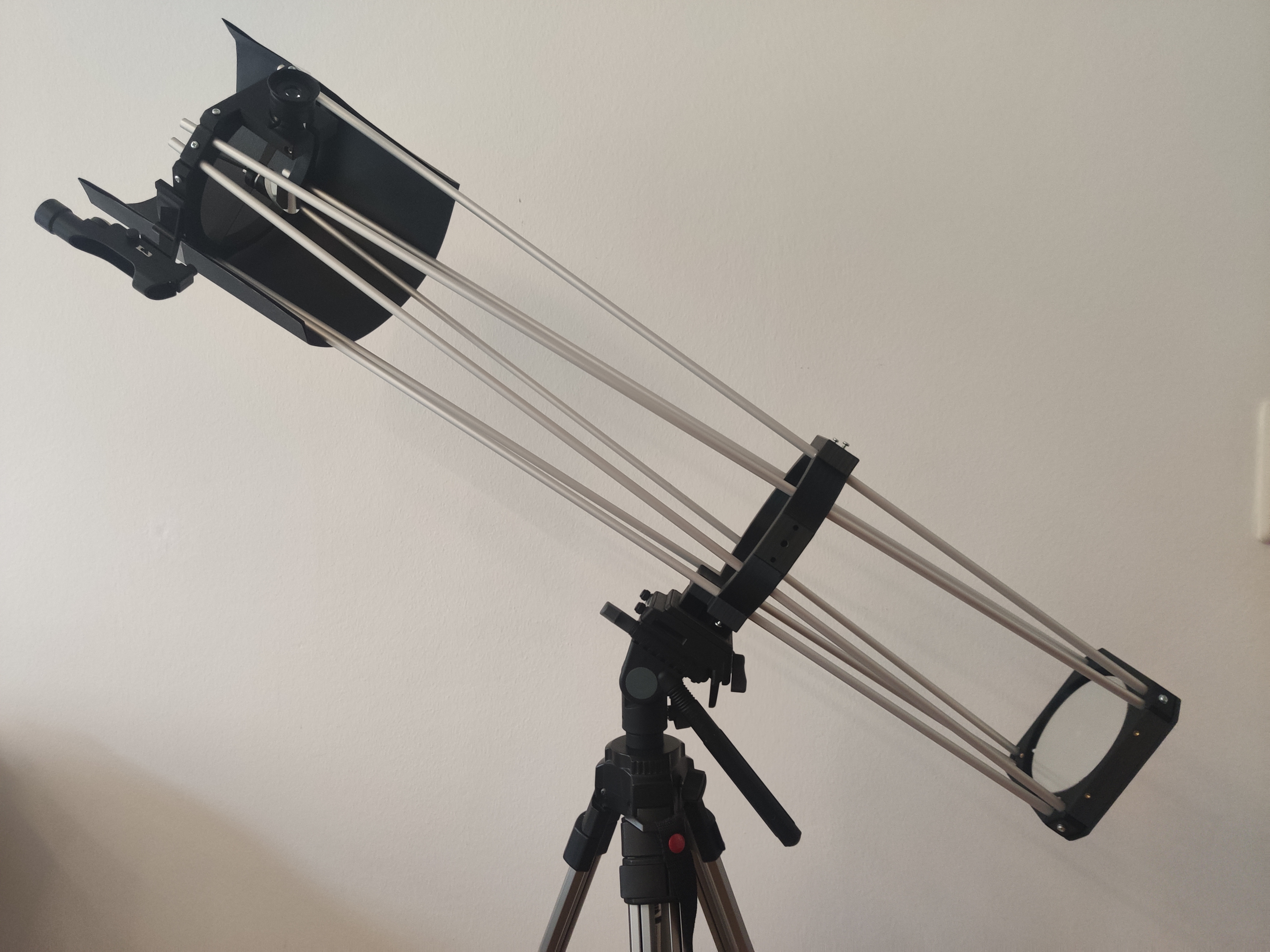
Telescope - ultralight, truss tube Newtonian design for astronomy - 114 mm mirror, 900 mm focal length
prusaprinters
<p>DO NOT LOOK AT THE SUN WITH THIS!</p><p>Also have a look at my improved Dobsonian Design:</p><p>https://www.printables.com/model/317112-propdob-telescope-foldable-travel-dobsonian-45-mir</p><p> </p><p>Hi, this is a Newtonian telescope with a 114 mm diameter mirror and therefore a bit more light gathering and resolving power than the typical beginner 70 mm refractor telescopes. Perfect for seeing craters on the moon as well as rings on Saturn and stripes on Jupiter.</p><p>The spherical <strong>114 mm diameter, 900 mm focal length mirror</strong> can often be found online in a set with the <strong>25 mm diagonal mirror</strong> for around 30 - 70 €. Do not worry to use a cheap spherical mirror - with the 114/900 specification it will be a sharp image and just as good as a parabolic mirror. Together with eight <strong>8 mm outer diameter 1000 mm length aluminium or wood rods, </strong>a handful of <strong>3 mm threaded inserts </strong>for creating threads in prints and a bunch of <strong>~16 mm long M3 screws</strong> this is still cheaper than a usual beginner telescope. Note, that you will also need a cheap Kellner or slightly better Plössl <strong>eyepiece </strong>(~10 €) or an eyepiece set and a (photographic) tripod with quarter-inch-screw mount. There are also m6 threads in the side of the telescope so you can attach a Dobsonian telescope mount, and I have included an stl for a dovetail mount for a cheap equatorial mount that could be used. You will also need <strong>two springs, e.g. from a ballpoint pen</strong>, which are used in the friction focuser and the diagonal mirror holder. The focuser works by sliding the eyepiece in and out - a light, simple solution that works quite well. </p><p>The magnification of the telescope is given by the focal length of 900 mm divided by the focal length of the eyepiece. An eyepiece with 10 mm is a good start and would give a 900mm/10mm= 90-fold magnification. Eyepieces must not be shorter focal length than 4 mm with this telescope and be advised that some of the best views are available not at maximum magnification but with a bit more overview, e.g. 10 mm or 20 mm. A cheap red dot viewfinder can be mounted to the telescope - this is needed to find Jupiter or Saturn in the sky but is not absolutely needed for the moon.</p><p>The design is inspired by the propdob foldable telescope from roelblog.nl and has the mirror resting on a cable tie glued to the side of the mirror on its centreline. The cable tie is gliding on a bit of Teflon (or another bit of plastic / a 3 mm printed plastic piece), while resting on three screws in the back that allow for collimating the telescope. See online collimation alignment tips and tricks, it is a bit complicated to learn but not bad once you understand it - even without additional tools star collimation is possible. Otherwise, there are also Chesire eyepieces that you can print. A bit of double-sided sticky tape is needed to glue the diagonal mirror in place and to secure the back mirror against falling out. The back mirror is loose in its cage so as to not deform it (a bit overkill for such a small mirror but does not hurt either). An advantage of the truss rod design is the ability to disassemble the telescope for storage or travel. Apart from that the ultralight design also minimises the print volume.</p><p><strong>Have fun with building your own telescope and please post a make (and thereby earn Prusameters of filament). Let me know if you have ideas for design changes and I am happy to draw alternative parts. Happy making!</strong></p><p> </p><p>PS: be realistic about the expectations of astronomical views, this telescope cannot compete with large telescopes - look for sample images of Saturn through a 114 mm telescope before building. It is good fun nevertheless and one learns a lot about optics and astronomy. Also be patient, “seeing” that is cloud cover, haze, atmospheric turbulence all make the views bad one day and great on the next day. Also note, that the above church-tower view is worse quality than looking by eye - a handheld smartphone photograph through an eyepiece does not do this telescope justice.</p><p> </p>
With this file you will be able to print Telescope - ultralight, truss tube Newtonian design for astronomy - 114 mm mirror, 900 mm focal length with your 3D printer. Click on the button and save the file on your computer to work, edit or customize your design. You can also find more 3D designs for printers on Telescope - ultralight, truss tube Newtonian design for astronomy - 114 mm mirror, 900 mm focal length.
